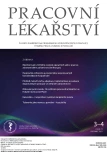Respiratory diseases in workers exposed to metalworking fluids
Authors:
S. Perečinský
Authors‘ workplace:
Klinika pracovného lekárstva a klinickej toxikológie, Lekárskej Fakulty Univerzity P. J. Šafárika a Univerzitnej Nemocnice L. Pasteura, Košice, prednosta prof. MUDr. Ľubomír Legáth, PhD.
Published in:
Pracov. Lék., 73, 2021, No. 3-4, s. 66-71.
Category:
Review Papers
Overview
Metalworking fluids are complex mixtures of oils, water and chemical additives used to reduce heat and friction and to remove metal particles in the metalworking process. The aerosol generated during the metalworking process poses a risk for the development of several respiratory diseases, of which allergic diseases are currently the most important. The aim of this work is to summarize the knowledge about occupational hypersensitivity pneumonitis and bronchial asthma induced by metalworking fluids. Sporadic cases of the disease may occur in individual workplaces, but the mass occurrence, which is most often described in the automotive industry, is also typical. The significant increase in cases of hypersensitivity pneumonitis in the last two decades in some Western European countries is well documented by several studies. However, the prevalence of asthma may be even higher compared to hypersensitivity pneumonitis. In the etiopathogenesis of hypersensitivity pneumonitis, microbial contamination of metalworking fluids is used, where the aqueous component represents a suitable environment for the multiplication of a wide range of microorganisms. These are mainly gram-positive and gram-negative bacteria and Mycobacteria. In some cases, mildews are also important. Asthma is rather induced by biocidal additives and endotoxin released from the damaged bacterial wall. Metals released into liquids during machining can also sensitize. Prevention is challenging as it is virtually impossible to completely decontaminate fluids. Cleaning the pipes and changing the fluids has only a short-term effect. On the other hand, biocides promote the growth of resistant microorganisms and can also sensitize. The risk can be reduced by changing the production technology, which eliminates the need to recirculate metalworking fluids.
Keywords:
Asthma – microorganisms – hypersensitivity pneumonitis – metalworking fluids – respiratory diseases
Sources
1. Bakerly, N. D., Moore, V. C., Vellore, A. D., et al. Fifteen-year trends in occupational asthma: data from the shield surveillance scheme. Occup Med (Lond), 2008, 58, 3, s. 169–174.
2. Barber, C. M, Burton, C. M., Hendrick, D., et al. Hypersensitivity pneumonitis in workers exposed to metalworking fluids. Am J Industr Med, 2014, 57, 8, s. 872–880.
3. Barber, C. M., Wiggans, R. E., Carder, M., Agius, R. Epidemiology of occupational hypersensitivity pneumonitis; reports from the SWORD scheme in the UK from 1996 to 2015. Occup Environ Med, 2017, 74, 7, s. 528–530.
4. Bernstein, D. I., Lummus, Z. L., Santilli, G, et al. Machine operator’s lung a hypersensitivity pneumonitis disorder associated with exposure to metalworking fluids aerosols. Chest, 1995, 108, 3, s. 636–641.
5. Burge, P. S., Moore, V. C., Burge, C. B. S. G., Vellore, A. D., Roberton, A. S., Robertson, W. Can serial PEF measurements separate occupational asthma from allergic alveolitis? Occup Med, 2015, 65, 3, s. 251–255.
6. Burge, P. S. Hypersensitivity Pneumonitis Due to Metalworking Fluid Aerosols. Curr Allergy Asthma Rep, 2016, 16, 8, s. 59.
7. Burton, C. M., Crook, B., Scaife, H., Evans, G. S. Systematic review of respiratory outbreaks associated with exposure to water-based metalworking fluids. Ann Occup Hyg, 2012, 56, 4, s. 374–388.
8. Cullen, M. R., Balmes, J. R., Robins, J. M., Smith, G. J. Lipoid pneumonia caused by oil mist exposure from a steel rolling tandem mill. Am J Ind Med, 1981, 2, 1, s. 51–58.
9. Dawkins, P., Robertson, A., Robertson, W., et al. An outbreak of extrinsic alveolitis at a car engine plant. Occup Med, 56, 8, s. 559–565.
10. Fishwick, D., Tate, P., Elms, J., et al. Respiratory symptoms, immunology and organism identification in contaminated metalworking fluid workers. What you see is not what you get. Occup Med (Lond), 2005, 55, 3, s. 238–241.
11. Fox, J., Anderson, H., Moen, T., et al. Metalworking fluid associated hypersensitivity pneumonitis: an outbreak investigation and case-control study. Am J Ind Med, 1999, 35, 4, s. 58–67.
12. Hendrick, D. J., Marshall, R., Faux, J. A., Krall, J. M. Positive alveolar responses to inhalation provocation tests: their validity and recognition. Thorax, 1980, 35, 6, s. 415–427.
13. Herwaldt, L. A., Gorman, G. W., McGrath, T., et al. A new Legionella species, Legionella feeleii species nova, causes Pontiac fever in an automobile plant. Ann Intern Med, 1984, 100, 3, s. 333–338.
14. Hodgson, M. J., Bracker, A., Yang, C., et al. Hypersensitivity pneumonitis in a metal-working environment. Am J Ind Med, 2001, 39, 6, s. 616–628.
15. James, P. L., Cannon, J., Barber, C. M., et al. Metal worker‘ s lung: spatial association with Mycobacterium avium. Thorax, 2018, 73, 2, s. 151–156.
16. Jones, J. G. An investigation into the effects of exposure to an oil mist on workers in the mill for the cold reduction of steel strip. Ann Occup Hyg, 1961, 3, 4, s. 264–271.
17. Legáth, Ľ. Úskalia diagnostiky profesionálnej astmy. I-med, 2013, ISSN 1338-4392.
18. Lison, D., Lauwerys, R., Demedts, M., Nemery, B. Experimental research into the pathogenesis of cobalt/hard metal lung disease. Eur Respir J, 1996, 9, 5, s. 1024–1028.
19. Metalworking Fluids: Safety and Health Best Practices Manual. OSHA, 1999. Dostupný na www:
Labels
Hygiene and epidemiology Hyperbaric medicine Occupational medicineArticle was published in
Occupational Medicine

2021 Issue 3-4
Most read in this issue
- Monitoring of indoor air of operating rooms in practice in a tertiary-type medical facility
- Tularemia as an occupational disease
- Case report – (un)professional carpal tunnel syndrome
- Respiratory diseases in workers exposed to metalworking fluids
